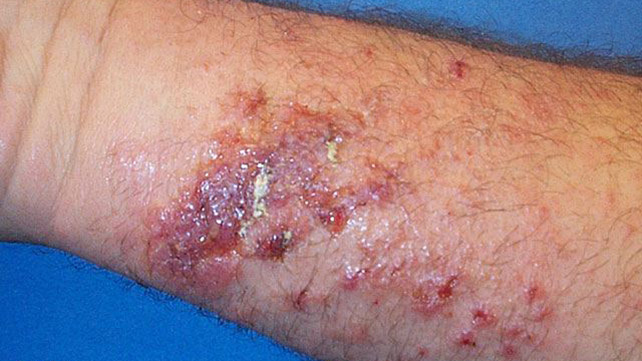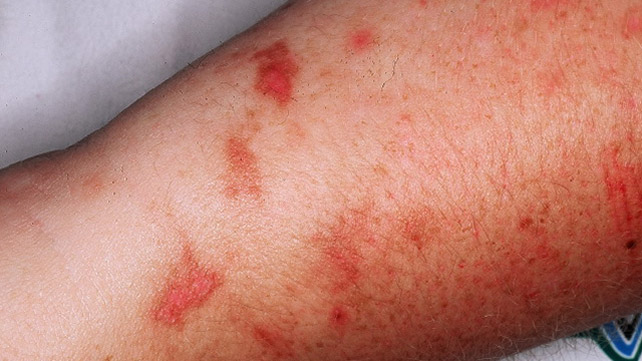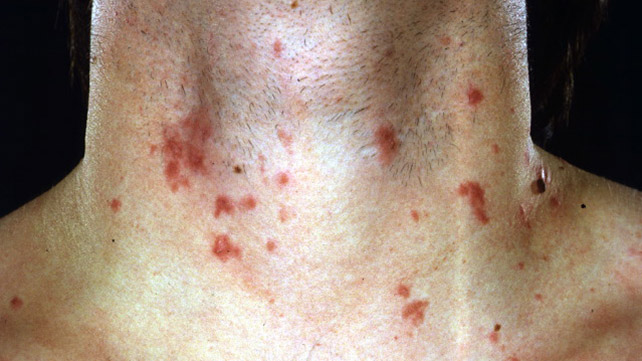Fitofotodermatitisz
trigonit kft
Fitofotodermatitisz - Fényérzékenységet okozó növények és napégés. Fitofotodermatitisz - Fényérzékenységet okozó növények és napégés. szerző: Huszár Zsoltné dr., szakgyógyszerész - WEBBeteg. megjelent: 2022.07.07. A fitofotodermatitisz (fitofotodermatitis) bizonyos növényekkel való érintkezés után fényhatásra kialakuló, napégéshez hasonlító bőrgyógyászati panasz, mely .. Fitofotodermatitisz - Dr. Siklos Krisztina. A jellegzetes, kacifántos alakzatú vörös csíkok, a növényi nedvvel való érintkezés helyén, a napfényhatást követő 24 órán belül alakulnak ki. Inkább égő érzést okoznak, és nem viszketnek. Súlyosabb esetekben akár kisebb hólyagok is megjelenhetnek, amik pár nap után maguktól kifakadnak.. Minden, amit a fitofotodermatitiszről tudni érdemes - Orvos 24. A fitofotodermatitis a kontakt dermatitisz egyik fajtája. Könnyebben érthető, ha a nevét három részre bontja: fito, ami növényt jelent. fotó, ami napfényt jelent. dermatitis, amely a bőr gyulladása. Ebben az állapotban bizonyos növényi vegyi anyagokkal való érintkezés bőrgyulladást okozhat, ha napfénynek van kitéve.. Fotokontakt dermatitis | Alai. Fitofotodermatitisz. A fotokontakt dermatitisz másik oka az UV sugárzás és a különböző növényekben található fényérzékenyítő vegyületek kölcsönhatásából ered. A bőrgyulladásnak ezt a típusát fitofotodermatitisznek nevezik. A fitofotodermatitist leggyakrabban okozó növénycsalád az Umbelliferae család.. Fitofotodermatitisz: fájdalmas bőrtünetek a kerti munkától. A fitofotodermatitisz néven ismert bőrtüneteket olyan gyakori, a kiskertekben is megtalálható zöldségfélék is képesek előidézni, mint a petrezselyem és a zeller. Az allergiás reakció megjelenéséért egy fényérzékenységet okozó anyag, a furokumarin a felelős.. Fitofotodermatitisz | Házipatika. fitofotodermatitisz; Fitofotodermatitisz. Cikkek Veszélyben Égési sérülést okozhatnak a nyári koktélok A nyár egyik legjobban várt része, hogy az ember a szabadban ücsörögve ehet, ihat, miközben magába szívja a tél során olyannyira nélkülözött napfényt, amely a D-vitamin termelődésének elsődleges ösztönzője. .. Fitofotodermatitisz napfény és zeller hatására - nlc.hu. Június 01. Egy anyuka figyelmeztette a szülőket az úgynevezett fitofotodermatitisz veszélyére, miután babájának hólyagos és vörös lett az arca egy zellerszár elfogyasztása után. A fitofotodermatitisz bizonyos növényekkel való érintkezés után fényhatásra kialakuló, napégéshez hasonlító bőrgyógyászati panasz.. Milyen növények okozhatnak napégéshez hasonló tüneteket?. Fitofotodermatitisz akkor jelentkezik, ha bizonyos növényekből fényérzékenyítő anyag kerül a bőrre, ami napfénnyel érintkezve égési sérüléshez hasonló tüneteket okoz. Külföldi szaklapokból válogatott tanulságos esetekkel hívjuk fel a figyelmet az ilyen esetek súlyosságára.. Növények, amelyek égési sérülést okozhatnak | Házipatika. Fitofotodermatitisz akkor jelentkezik, ha bizonyos növényekből fényérzékenyítő anyag kerül a bőrre, ami napfénnyel érintkezve égési sérüléshez hasonló tüneteket okoz. Külföldi szaklapokból válogatott, tanulságos esetekkel hívjuk fel a figyelmet a fitofotodermatitiszes esetek súlyosságára.. Három gyakori ok, amivel bőrgyógyászhoz fordulunk a nyári hónapo. - Fitofotodermatitisz esetén fontos, hogy ne kertészkedjen direkt napsütésben, emellett a megelőzéshez védőruházat viselése is javasolt. A magas faktorszámú napvédő krém ugyanis a furokumarin fényérzékenyítő hatása ellen nem nyújt elegendő védelmet. - Panaszok esetén ne kísérletezzünk otthoni kezeléssel.. A három leggyakoribb nyári bőrporbléma | Házipatika. - Fitofotodermatitisz esetén fontos, hogy ne kertészkedjünk direkt napsütésben, emellett a megelőzéshez védőruházat viselése is javasolt. A magas faktorszámú napvédő krém ugyanis a furokumarin fényérzékenyítő hatása ellen nem nyújt elegendő védelmet .. Veszélyes nasik - nem is hinnéd, milyen reakciót okozhatnak ezek az .. A fitofotodermatitisz napégéshez hasonlító bőrgyógyászati probléma, amely fény és bizonyos fényérzékenyítő hatású növényi kemikáliák miatt alakul ki
nespresso újratölthető kávékapszula
. Az UV-sugárzás hatására létrejövő reakció károsítja a bőr szövetét - és ez az érzékeny bababőrön kimondottan súlyossá válhat, akár másodfokú .. Cikkek és kérdések: Fitofotodermatitisz téma - WEBBeteg. Fitofotodermatitisz - Fényérzékenységet okozó növények és napégés WEBBeteg - Huszár Zsoltné dr., szakgyógyszerész - 2022.07.07. 11:33 A fitofotodermatitisz (fitofotodermatitis) bizonyos növényekkel való érintkezés után fényhatásra kialakuló, napégéshez hasonlító bőrgyógyászati panasz, mely odafigyeléssel .. PDF Nemzetgazdasági Minisztérium Munkafelügyeleti F osztályának .. 1 A Nemzetgazdasági Minisztérium Munkafelügyeleti F osztályának tájékoztatása a mez gazdasági munkák során kialakuló fototoxikus b rreakcióról (fito-fotodermatitisz) Nyári mez gazdasági munkáknál a fizikai munkavégzésb l származó kockázatokon és a. Fényérzékenységet, bőrgyulladást okozó növények | Vital.hu. Bizonyos növények levelében olyan fényérzékenyítő anyag található, amely a bőrrel érintkezve, napsütés hatására égési sérüléshez hasonló, súlyos allergiás reakciót okozhat. A fitofotodermatitisz néven ismert bőrtüneteket olyan. Ezeket a növényeket óvatosan fogyaszd nyáron: megéghet . - Dívány. A fitofotodermatitisz néven ismert jelenség igen kellemetlen, napégésre hasonlító tünetekkel jár. Ha előfordult már veled, hogy egy kerti sütögetés vagy egy vízparti iszogatás után furcsa égési sérüléseket találtál magadon, te is a saját bőrödön tapasztalhattad meg a fitofotodermatitiszt, melynek sokan a .. Ezért vigyázzon a petrezselyemmel, ha beköszönt a nyár. Az egyik legérdekesebb, kellemetlen napfénnyel kapcsolatos bőrbetegség a fitofotodermatitisz. „Az UV fény hatására mind a pigmentsejt eredetű daganatok (melanóma) mind a hámsejt eredetű elváltozások rizikója megnövekedik. Éppen emiatt nagyon fontos, hogy 11 és 15 óra között kerüljük a napozást, használjunk fényvédő készítményeket és mechanikai védelemmel, azaz .. Itt a nyár és itt vannak a szúnyogok is - Dr. Siklos Krisztina. Fitofotodermatitisz 2019-07-24. Összes mutatása. Itt a nyár és itt vannak a szúnyogok is. szúnyogcsípés kezelése bőrgyógyászat. Az idei esős, borongós május után végre megérkezett a napsütötte, lelket is melengető június, de sajnos ezzel együtt itt vannak a szúnyogok is. Kétségtelenül kevés olyan állat él a .. Vélemény: Fitofotodermatitisz - NOL.hu. Napok óta írják a hírrovatok, hogy ötven baksi napszámost kellett a fitofotodermatitisz miatt kórházba vinni, mert meztelen lábszárral gyomlálták a petrezselymet egy kertészetben.. Fitofotodermatitisz kezelése: Hogyan kezeljük a citrusfélék égési .. A fitofotodermatitisz a furokumarinok kémiai vegyülete (a kis zöld citrusfélékben található fényérzékenyítő) és az ultraibolya A sugárzás közötti fototoxikus reakció. A vegyi anyagok a bőrt szuperérzékennyé teszik a napfényre, ami miatt az a normálisnál könnyebben leég.. Fitofotodermatitisz - fényérzékenységet okozó növények - YouTube. #teddmeg #fitofotodermatitisz #füge. fitofotodermatitisz - Gyerekszoba. fitofotodermatitisz Veszélyes nasik - nem is hinnéd, milyen reakciót okozhatnak ezek az ételek Gondolnád, hogy akár egy ártatlannak tűnő zellerszár komoly sérülést okozhat a gyerekeknél?. Blog - Bőrgyógyászati rendelés Budapesten-Dr.Siklós Krisztina. Fitofotodermatitisz. Bizarr alakú csíkok a bőrön, amik megkeseríthetik a nyarat Nyáron gyakran keresnek fel a rendelőben felnőttek és gyerekek egyaránt, bőrükön furcsa alakzatú, vörös, vagy barnás csíkokkal. Általában nem gondolják, hogy […] Olvasás tovább.. Phytophotodermatitis: This Weird Sun Reaction Could Ruin Your Summer - SELF
kristálycukor kalória
. Phytophotodermatitis looks like an allergic skin reaction, but its actually a chemical burn from the sun. This reaction happens when you expose your skin to certain plant compounds and then to .. Phytophotodermatitis symptoms and treatment - MD Anderson Cancer Center. Phytophotodermatitis has to run its course; there is no cure. Treatment consists of managing pain and itching. If youre able to catch it early, Chon recommends seeing a dermatologist, who can prescribe topical steroids to reduce the inflammation and offer wound care suggestions. Mild cases can be treated with over-the-counter non-steroidal .. Photodermatoses: Diagnosis and Treatment - PMC - National Center for .. Methods. We selectively reviewed the literature of the past 20 years and describe the modern nosology of photodermatoses and their clinical features, diagnosis, and treatment

nikotinos hevítőrúd
. low blood pressure. headache

szent györgy hegy eladó ingatlan
időkép előrejelzés
. fainting. These kinds of allergy symptoms are more likely to happen if you stay in the sun for a long time and large areas of .. Lime-induced phytophotodermatitis - PMC - National Center for .. Phytophotodermatitis is a dermatitis caused after the skin is exposed to photosensitizing compounds in plants and then exposed to sunlight. Many common plants including citrus fruits, celery, and wild parsnip contain these photosensitizing compounds which cause phytophotodermatitis. It is important for a physician to be aware of .. Photosensitivity disorders (photodermatoses): Clinical manifestations .

krizantém palánta
. Symptoms usually occur only on skin that has been exposed to the sun or other source of UV light. Symptoms show up within minutes to hours after sun exposure.. Sunburn - StatPearls - NCBI Bookshelf. Sunburn is an acute inflammatory skin reaction occurring due to extended exposure to ultraviolet (UV) rays from the sun or artificial sources such as tanning beds. The intensity and duration of UV exposure, along with factors such as medication usage, time of day, ozone depletion, high altitude, clear skies, and skin phototype, primarily influence the risk of sunburn. To decrease the risk of .. Margarita Burn: The Danger of Mixing Lime Juice and Sun - Healthline. Margarita burn is a condition known as phytophotodermatitis. "The term phyto means plant, photo refers to light, and dermatitis is the inflammation of the skin," explained Dr .. Outdoor Workers and Poisonous Plant Exposures | Blogs | CDC. Other wild plants, such as wild parsnip and the invasive giant hogweed, contain phototoxins called furanocoumarins. When rubbed on the skin, furanocoumarins react with UV light to cause phytophotodermatitis (2, 11). If a person ingests furanocoumarins, it can cause liver damage, cellular mutations, and death (2, 4, 6, 7). Further Research Needed. Five Cases of Phytophotodermatitis Caused by Fig Leaves and Relevant .. Phytophotodermatitis is a condition caused by sequential exposure to photosensitizing substances present in plants followed by ultraviolet light. Several plants (e.g., limes, celery, fig, and wild parsnip) contain furocoumarin compounds (psoralens). It is important for dermatologists to be aware of phytophotodermatitis because it may be .. Dermatitis. Photosensitivity dermatitis | DermNet. Photosensitivity dermatitis is the name given to an eczematous eruption arising in response to exposure to electromagnetic radiation. It is most commonly provoked by exposure to sunlight. The reaction may relate to UVB, UVA and/or visible light. It arises in all skin types. Photosensitivity dermatitis has several causes.. Phytophotodermatitis - an overview | ScienceDirect Topics

elle kennedy könyvek pdf
. Sun Allergy (Photosensitivity) - Harvard Health. A sun allergy is an immune system reaction to sunlight, most often, an itchy red rash. The medical term for this condition is Polymorphous Light Eruption (PMLE). The most common locations include the "V" of the neck, the back of the hands, the outside surface of the arms and the lower legs. In rare cases, the skin reaction may be more severe .. Phytophotodermatitis - PMC - National Center for Biotechnology Information. Phytophotodermatitis is a nonimmunologic phototoxic cutaneous eruption resulting from contact with photosensitizing substances found in plants; furocoumarins (present in limes and other plants) are typically implicated and get activated following exposure to sunlight (especially ultraviolet A rays, 320-400 nm). 1 Although simple photoallergic .

lioton gél gyakori kérdések
. This hyperpigmentation can occur even in mild cases of phytophotodermatitis.
fazilet asszony és lányai 81 rész videa magyarul
huawei sun2000-10ktl-m1 ár
. Suns effect on skin - Health Video: MedlinePlus Medical Encyclopedia. The suns ultraviolet light can cause major damage to the skin. The outer layer of the skin has cells that contain the pigment melanin. Melanin protects skin from the suns ultraviolet rays. These can burn the skin and reduce its elasticity, leading to premature aging. People tan because sunlight causes the skin to produce more melanin and darken.. Phytophotodermatitis - Plants that cause it and home remedies. What is phytophotodermatitis? In laymans terms, a plants sap just gave you a MAJOR sunburn. Some plants contain a substance called furanocoumarin or furocoumarins which causes your skin to become extra sensitive to UV light. Its not an allergic or immune response, but a sun-sensitive skin reaction from a plants juices that leads to .. Plant dermatitis | DermNet. Plant dermatitis is an inflammation of the skin caused by topical contact with a plant or plant constituent. Phytodermatitis is the formal medical name for plant dermatitis, and it may be an irritant contact dermatitis, allergic contact dermatitis, or phytophotodermatitis. Contact urticaria and mechanical irritation can also be due to plants.. Polymorphic light eruption - NHS. Symptoms of polymorphic light eruption. An itchy or burning rash appears within hours, or up to 2 to 3 days after exposure to sunlight. It lasts for up to 2 weeks, healing without scarring. The rash usually appears on the parts of the skin exposed to sunlight, typically the head, neck, chest and arms. The face is not always affected.. Photosensitivity - The Skin Cancer Foundation. Photosensitivity is heightened skin sensitivity or an unusual reaction when your skin is exposed to UV radiation from sunlight or a tanning bed. You can become photosensitive as a result of prescription or over-the-counter medications, a medical condition or genetic disorder, or even by using certain types of skin care products. There are two distinct types of photosensitivity reactions .. Photosensitivity: Definition & Patient Education - Healthline. Photosensitivity is an extreme sensitivity to ultraviolet (UV) rays from the sun and other light sources. Most people are at risk of developing sunburn during long exposure to sunlight. Exposure .. Photosensitivity Reactions - Skin Disorders - MSD Manual Consumer Version. Photosensitivity Reactions. Photosensitivity, sometimes referred to as a sun allergy, is an immune system reaction that is triggered by sunlight. Sunlight can trigger immune system reactions. People develop itchy eruptions or areas of redness and inflammation on patches of sun-exposed skin. The diagnosis is usually based on a doctors evaluation.. The Dangers Of Phytophotodermatitis: Blisters From Lime Juice. Phytophotodermatitis is a skin reaction that occurs when the skin is exposed to certain chemicals found in plants. The chemicals in the plants cause the skin to become sensitive to sunlight. The result is a red, itchy, and blistering rash. Phytophotodermatitis can be treated with over-the- counter antihistamines and topical corticosteroids.. Sun-Sensitive Drugs (Photosensitivity to Drugs) - MedicineNet. Some medical conditions are known to cause sensitivity to sun exposure. Systemic lupus erythematosus often causes a rash on the face which can be very sensitive to sunlight. This rash is typically seen on the nose and cheeks, called a malar rash, and is considered one of the hallmarks of lupus.; Porphyria is another medical condition that may cause photosensitivity reactions.. Sun Rash: What It Looks Like, Symptoms, Causes, Treatment - Verywell Health. The most common form is the papular sun rash. This looks like small, red, smooth-topped bumps situated close together, all in the same area. These bumps can then form raised red patches called plaques. These typically appear on the arms, legs, and chest. Plaques can also include fluid-filled blistered areas called vesicles.. Sunlight and Vitamin D - PMC - National Center for Biotechnology .. Abstract. Vitamin D is the sunshine vitamin that has been produced on this earth for more than 500 million years. During exposure to sunlight 7-dehydrocholesterol in the skin absorbs UV B radiation and is converted to previtamin D3 which in turn isomerizes into vitamin D3.. Sun Exposure | CDC Yellow Book 2024. Phytophotodermatitis

g1 fitness gödöllő
. Poison ivy grows as a low shrub or on vines. Each leaf on a poison ivy plant has three smaller leaflets. Touching any part of the plant can cause red, swollen skin, blisters and severe itching. This skin reaction sometimes happens within just a few hours of coming into contact with poison ivy. A poison ivy rash usually goes away within 1 to 2 .. Phytophotodermatitis Clinical Presentation - Medscape. Phytophotodermatitis (PPD) is a cutaneous phototoxic inflammatory eruption resulting from contact with light-sensitizing botanical substances and long-wave ultraviolet (UV-A 320-380 nm) radiation. The eruption usually begins approximately 24 hours after exposure and peaks at 48-72 hours.. How Sunburn and Sun Tans Work | HowStuffWorks. The living, inner layer is called the malpighian layer. The malpighian layer creates the dead cells that we can see. It is in direct contact with the dermis, which feeds and supports it. The malpighian layer is our focus of attention actually, because it is here that the sun affects the skin during tanning.. Itching for Some Sun - Penn Medicine. Similar to phytophotodermatitis, symptoms result from the interaction between UV rays and certain chemicals in the medications. Non-steroidal anti-inflammatory drugs (which are commonly referred to as NSAIDs and include medications like Ibuprophen and Naproxen), Retin-A, and certain diuretics and antibiotics, are known to lead to either .. Phytophotodermatitis: Everything You Need To Know About The . - BuzzFeed. Phytophotodermatitis is a rash that "occurs when chemical compounds called furocoumarins interact with UVA radiation from the sun," Dr. Park told BuzzFeed. Getty Images. "Furocoumarins are found .. Polymorphic light eruption (PMLE) — DermNet. Polymorphic light eruption (PMLE) is a seasonal, acquired, idiopathic photodermatosis occurring in spring and early summer
. It is also known as polymorphous light eruption, sun allergy, sun poisoning, prurigo aestivalis, summer eruption/prurigo, or eczema solare. Juvenile spring eruption is a variant of PMLE.. Contact Dermatitis - StatPearls - NCBI Bookshelf. Contact dermatitis is an inflammatory eczematous skin disease. It is caused by chemicals or metal ions that exert toxic effects without inducing a T-cell response (contact irritants) or by small reactive chemicals that modify proteins and induce innate and adaptive immune responses (contact allergens).[1][2][3][4]. Giant hogweed: What to know about invasive plant that blinds and burns .. The sap of giant hogweed contains a chemical that triggers a condition known as phytophotodermatitis. This condition renders the skin extremely sensitive to sunlight, leading to severe burns and .. Photosensitivity, Photo-induced Disorders, and Disorders by Ionizing .. Plant induced (phytophotodermatitis) Photoallergy Drug/chemical induced Chronic actinic dermatitis Solar urticaria. Idiopathic Polymorphous light eruption Actinic prurigo a Hydroa vacciniforme a. Metabolic and nutritional Porphyria cutanea tarda Variegate porphyria Erythropoietic protoporphyria Pellagra. DNA-deficient photodermatoses.